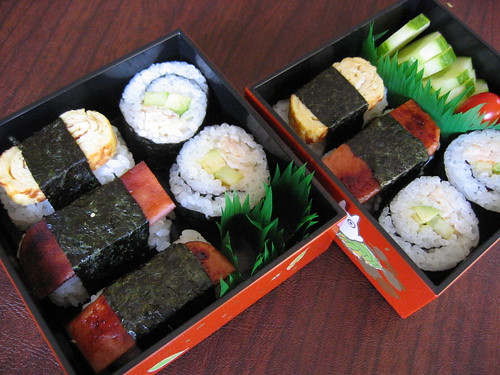I'll be honest, here...there are rumors in my family that there was once a miner married to a Native American woman. But those remain unconfirmed. I'm white. Fishbelly, burns in ten minutes of sun, goth is default merely because I rather like black, white. And I'm in love with this cookbook.
It's not the food of my grandmothers, in any way, shape, or form. It's about as foreign to me as a cookbook could get. But it is Great Grandmother's Food for millions of people. Jessica B Harris does an excellent job of weaving together recipes and stories from her travels, making the food of Africa accessible and engaging.
Posted by
J.W.
Now the Harvest is in,
Grain is in the bin.
Through hard work and God's aid
The year's rent has been paid.
With Pennies to spare
We're off to the Michaelmas Fair!
Category:
apples,
berries,
history,
holidays,
poultry,
Saint's Days
1 comments
Posted by
J.W.
As much as I love the old and retro, all of us have some meals that we look back on with a mixture of amusement and downright horror.
Category:
American history,
cookbooks,
plugs,
retro
0
comments
Posted by
J.W.
 |
| Cookingcute.com, a great resource, although no longer live. |
Category:
Japanese Food,
vegetarian/vegan
3
comments
Posted by
J.W.
 |
| From the Cornell Library |
It probably comes as no surprise that I have at least one Medieval cookbook. Pleyn Delit
For a cookbook from an era before standard measurements is no small thing, since it allows the cook to interpret the recipe based on their own intuition.
Most Medieval Cookbooks, though, Pleyn Delit included, have a tendency to focus on Norman influences, and with good reason. The Normans had a much more diverse court, with trendy food, using lots of different sauces, and even showcasing recipes from the Moors in Spain. There is also a greater emphasis on spices and presentation, with "subtleties", foods that were meant to look like something else, being a big-ticket item.
 |
| A King with his witan (council). |
We can spend more time on those another time....If it's not as exciting, why do I have a soft spot for Anglo-Saxon food?
1) It's simplicity makes it easy for the lone cook to re-create. Even with modern technology, a late Medieval feast requires months of planning and a committed team to pull off. I did my first Norman dinner at the age of 14, and for a family of five, it took three weeks prep, and two solid days of cooking. Most Anglo Saxon food is so simple that with a little searching for items that aren't a regular part of the modern palate(but still sold at the average super-market), you could prepare it for a family dinner at home.
 | ||||
| From Saebert's Folc, and Essex reenactment group. More great pictures at their site. |
3) Including more diversity in your life. The average person has a set group of foods they buy in the store, that they rarely diverge from (think about what you buy in a month). Many foods that were common to our ancestors have fallen out of favor, and often have never even been tasted by modern generations! When was the last time you had nettles, or turnips, or rabbit? How do you know you don't like them unless you try?
Here's a simple, tasty start, from the above British Museum Cookbook:
Griddled Trout With Herbs Serves 6 The herbs below are what might have been used in Anglo-Saxon East Anglia, but use whatever you might fancy. Try to use fresh, although dried is acceptable. 6 fresh cleaned trout 6 sprigs fresh rosemary, or 1-2 tablespoons dried 75g (3 oz) soft butter 18 fresh mint leaves or 2 teaspoons dried leaves from 6 sprigs fresh thyme or 2 teaspoons dried 6 fresh sage leaves or 1 scant teaspoon dried 1-2 teaspoons coarse sea salt 6-9 grinds black pepper Put one sprig or generous shake of rosemary down the middle of each fish. Chop all the other herbs and seasonings and mash them into the soft butter. Use this to coat the fish generously on each side. Griddle, barbeque or grill it for 4-5 minutes on each side or till the skin is well browned and the flesh flaking off the bone. Baste now and then with the butter which runs off. Serve at once with lot of fresh bread and a salad or a simple green vegetable.
More basic information.
More Saxon and Viking recipes.
Category:
Anglo-Saxons,
cookbooks,
fish,
Medieval Europe,
recipes
2
comments
Posted by
J.W.
 | |||
| As the aliens eyed the seating arrangements with suspicion...all hope of the embassy dinner's success evaporated. |
I don't think there is an adult middle-class American woman alive who doesn't have an opinion about Martha Stewart.
Category:
humor,
lists,
ravings
0
comments
Posted by
J.W.
I usually talk about very women-oriented stuff on here...today is an exception.
 One of my favorite sites these days is The Art of Manliness. No, it's not geared towards me, by any stretch of the imagination. Instead, this site generates a feeling that is the online equivalent of the now extinct Men's Lodge,
One of my favorite sites these days is The Art of Manliness. No, it's not geared towards me, by any stretch of the imagination. Instead, this site generates a feeling that is the online equivalent of the now extinct Men's Lodge,
 One of my favorite sites these days is The Art of Manliness. No, it's not geared towards me, by any stretch of the imagination. Instead, this site generates a feeling that is the online equivalent of the now extinct Men's Lodge,
One of my favorite sites these days is The Art of Manliness. No, it's not geared towards me, by any stretch of the imagination. Instead, this site generates a feeling that is the online equivalent of the now extinct Men's Lodge,
Category:
history,
plugs,
salmon,
the Victorians
0
comments




